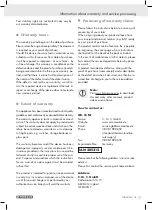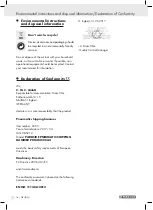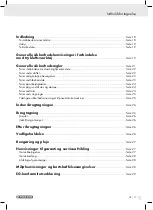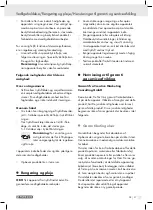
12 GB/IE/NI
General safety rules / Before using / Start-up
General safety rules
Risk assessment should include dust created by
the use of the tool and the potential for disturb-
ing existing dust.
Operate and maintain the non-rotary percussive
power tool as recommended in the instructions
handbook, to minimize dust or fume emissions.
Direct the exhaust so as to minimize the distur-
bance of dust in a dust-filled environment.
Where dust or fumes are created, the priority
shall be to control them at the point of emission.
All integral features or accessories for the collec-
tion, extraction or suppression of airborne dust
or fumes should be correctly used and main-
tained in accordance with the manufacturer’s
instructions.
Select, maintain and replace the consumable /
inserted tool as recommended in the instructions,
to prevent an unnecessary increase in dust or
fumes.
Use respiratory protection in accordance with
employer’s instructions and as required by oc-
cupational health and safety regulations.
Depending on the material you are working on,
dust and gasses produced can be hazardous
to the health of the operator (e.g. cancer, birth
defects, asthma and / or dermatitis).
Be aware, air emitted must raise as little dust as
possible.
Wear a dust mask meant for the application and
the generally applicable safety rules!
Noise hazards
Exposure to high noise levels can cause perma-
nent, disabling hearing loss and other problems,
such as tinnitus (ringing, buzzing, whistling or
humming in the ears). Therefore, a risk assess-
ment and implementation of appropriate controls
for these hazards are essential.
Appropriate controls to reduce the risk may
include actions, such as damping materials to
prevent workpieces from “ringing”.
Use hearing protection in accordance with
employer’s instructions and as required by
occupational health and safety regulations.
Operate and maintain the non-rotary percussive
power tool as recommended in the instructions
handbook, to prevent an unnecessary increase
in noise levels.
Select, maintain and replace the consumable /
inserted tool as recommended in the instructions
handbook, to prevent an unnecessary increase
in noise.
If the non-rotary percussive power tool has a si-
lencer, always ensure it is in place and in good
working order when the non-rotary percussive
power tool is operating.
Noise can cause permanent hearing damage.
Unprotected exposure to high noise levels can
result in permanent hearing loss and other prob-
lems such as tinnitus, (ringing, buzzing, whistling
or humming in the ears). Wear hearing protection.
Observe the maintenance and operating in-
structions in the instructions for use to keep the
noise and vibration generated as low as possible.
Vibration reducing material as a pad, e.g. when
processing sheet steel, can also reduce noise.
Hazard due to vibration
Exposure to vibration can cause disabling dam-
age to the nerves and blood supply of the hands
and arms.
Wear warm clothing when working in cold
conditions and keep your hands warm and dry.
If you experience numbness, tingling, pain or
whitening of the skin in your fingers or hands,
stop using the non-rotary percussive power tool,
tell your employer and consult a physician.
Operate and maintain the non-rotary percussive
power tool as recommended in the instructions
handbook, to prevent an unnecessary increase
in vibration.
Do not hold the inserted tool with the free hand,
as this increases vibration exposure.
Hold the tool with a light but safe grip, taking
account of the required hand reaction forces,
because the risk from vibration is generally
greater when the grip force is higher.
Keep suspended handles in the central position
and avoid pushing the handles into the end stops.
For breakers, cut small “bites” of concrete to
prevent the tool from jamming.














































